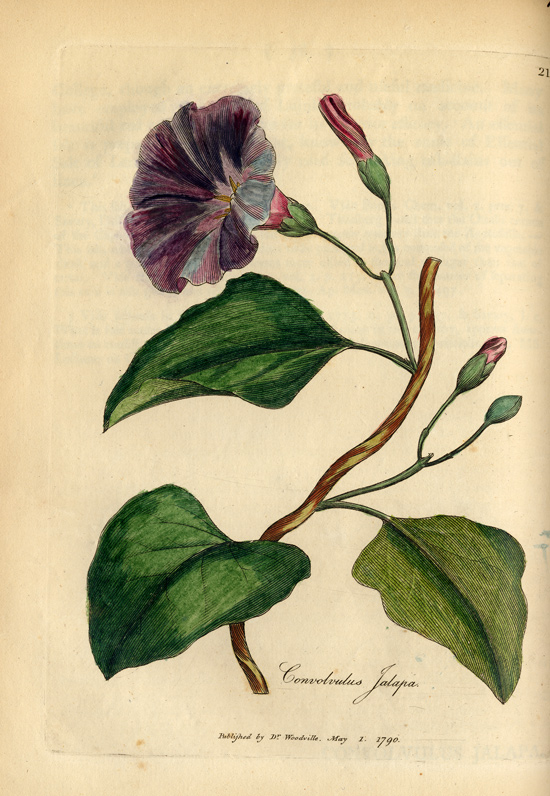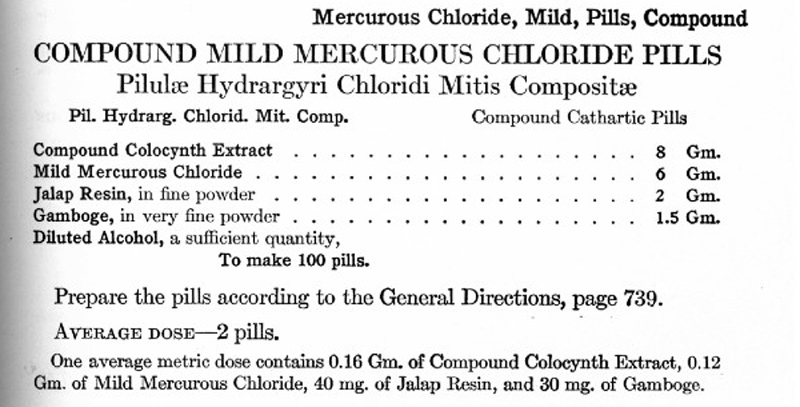John Fisher made these historical replicas following the National Formulary recipe (see below).
American-made from imported ingredients—One significant medicine was not imported–the famous Bilious Pills of Benjamin Rush. (They were actually anti-bilious pills. A patient was said to be “bilious” when supposed poor flow of bile in the body caused a complex of symptoms including constipation, headache, and lassitude.)
Dr. Rush had expressly indicated to Lewis that when one of his men showed the “sign of an approaching disease . . . take one or two of the opening pills.” Nicknamed “Rush’s Thunderbolts,” the pills were reputed to contain 10 grains of calomel and 10 to 15 grains of jalap, both potent laxatives. By opening up the bowels, Rush believed that the body would then expel the excess bile or other matter causing illness. (With active ingredients weighing at least 1295 mg, these would have been large pills indeed. A common aspirin tablet weighs 5 grains or ¼ the weight of the “thunderbolts.”)[1]Drake W. Will, “The Medical and Surgical Practice of the Lewis and Clark Expedition,” Journal of the History of Medicine, 14 (1959): 280-282.
Calomel
The two active ingredients had widely different sources and histories. Calomel (mercurous chloride) had entered medical practice in the 1600s as a milder and more palatable mercury compound. The liquid metal mercury had been applied externally in different forms since ancient times to treat a variety of skin lesions. A confluence of factors led to its rise as an internal medicine: the appearance of syphilis in Europe and the increasing influence of alchemy and chemistry on medical theories. The Swiss physician Paracelsus (1493-1541) and his followers argued that some of the new chemicals coming out of laboratories could better treat the diseases of a new age with a “new world.” The apparent success of mercury compounds against syphilis helped to spur the growing reputation of chemical medicines. Like almost all of the other fine chemicals in the medicine chests, the calomel came to the young United States from London suppliers.[2]George Urdang, “The Early Chemical and Pharmaceutical History of Calomel,” Chymia, 1 (1948): 93-108. Haynes, American Chemical Industry, 212-213.
By 1800, calomel was widely accepted for its general powers as an “alterative,” i. e., medicine that altered the overall constitution of the body. In large doses, calomel acted quickly as a laxative; in small doses over time, it produced what we today would characterize as mercury poisoning–abundant salivation, sore gums, loosening of teeth, metallic halitosis, and discolored stool. At this level, the drug was obviously “working” and had the power, in theory, to eliminate syphilis from the body. Because of its dual activity, calomel was included in both Rush’s Pills–eliminating excess bile through purging–and by itself in powder form, where it could be given in small doses over time to combat syphilis.[3]Edinburgh New Dispensatory, (1791), 438-440. Guenter B. Risse, “Calomel and he American Medical Sects During the Nineteenth Century,” Mayo Clinic Proceedings, 48 (1973): 57-64.
Jalap
Jalap came from the vegetable kingdom–the appropriately named plant Exogonium purga. The Edinburgh New Dispensatory, a book known well by Rush, calls jalap “a safe purgative, performing its office mildly; seldom occasioning nausea or gripes.” It came to the attention of European physicians in the early 1600s. Two hundred years later, when Rush used it liberally, the exact source of the root was not yet determined. It would be Rush’s student, John Redman Coxe, who in 1829 reported that jalap came from a Mexican plant. Jalap remained an official drug in the United States until 1965. Like calomel, powdered jalap was included in the medicine chest of the Corps as a separate drug.[4]Edinburgh New Dispensatory, (1791), 209-210; Lloyd, Pharmacopeial Vegetable Drugs, 176-177; National Formulary, 11th ed. (Washington, DC: American Pharmaceutical Association, 1960), 185.
Traveling down the Ohio on his way to St. Louis to start the expedition, Lewis came down with an attack of ague and dosed himself with Bilous Pills. He believed it helped. Both Lewis and Clark were free with their use of Rush’s Pills, which is not too surprising since so many of the complaints they faced had gastro-intestinal sequelae. The uneven and impure food supply, the back and forth switching from foods without fiber to high fiber, among other factors, no doubt contributed to a significant amount of constipation. In addition, some fevers and other complaints were associated with theories of excess bile or blood in the body. A good purging helped with that problem! Fortunately, Lewis and Clark had chosen their men well. Hardy frontiersmen, they were able to survive both the severe conditions of the long journey and the strong medicines imported from around the globe![5]Eldon G. Chuinard, Only One Man Died: The Medical Aspects of the Lewis and Clark Expedition (Glendale, California: Arthur Clark Company, 1979), 175-176, 273, 303, 321-322, 348.
Worldwide there are some 500 species of the genus Ipomúa, which includes twining plants such as the morning glory and the sweet potato. Carl Linnaeus gave it its generic name, which came from a Greek word denoting bindweed. Actually these vines, all of which have funnel-shaped and radially symmetrical flowers, comprise the Morning Glory family, or Convolvulaceae.
The only species with known medical value as a purgative is jalapa, so-named from the town of Jalapa in Mexico, 120 miles southeast of Oaxaca on the isthmus of Mexico, where it was first found in use by Indian people sometime in the 16th century. Three hundred years later it still fulfilled the role of an all-around tonic and cureall, which was no doubt why Clark administered it—along with some “Salts & Tarter emetic” for good measure—to the men who had become ill after eating their first meal of dried salmon and camas bread, which the Nez Perce Indians fed them upon their arrival at Weippe Prairie in late September of 1805.
Lewis bought only a half-pound of powdered jalap for his medicine chest, but it happens also to be one of the two active ingredients—the other being calomel (mercurous chloride)—that doubled the purgative effects of Dr. Rush’s “Bilious Pills,” of which Lewis carried a supply of 50 dozen.
Recipe
A milder version of Rush’s Pills remained an official compound until the 1940s. Here is the recipe for Compound Mild Mercurous Chloride Pills that appeared in the 1946 edition of the National Formulary. This “mild” formula was nonetheless a big gun, combining four purgatives of slightly differing qualities. Early 19th-century physicians regarded jalap as “active” and “rapid.” Gamboge, from Cambodia, was a “drastic” and “powerful” purge. Calomel (mercurous chloride) was believed to stimulate the liver and the gall bladder, although the opposite was true. Colocynth, or bitter apple, from India and Saharan Africa, was termed a “drastic” and “powerful” purge. According to the United States Dispensatory[6]Dispensatories are books that provide detailed information about the drugs and other ingredients that compose medicines defined in formularies and pharmacopeias. For example, a formulary might have a … Continue reading of 1918, the compound extract of colocynth “combined with calomel, extract of jalap, and gamboge . . . forms a highly efficient and safe cathartic, especially useful in congestion of the portal circle and torpidity of the liver.”
By the 1960s, newer drugs and concerns about heavy metal poisoning led to the disappearance of mercury compounds for internal use. Only a few external mercury-containing antiseptics remained into the 1990s.
Notes
| ↑1 | Drake W. Will, “The Medical and Surgical Practice of the Lewis and Clark Expedition,” Journal of the History of Medicine, 14 (1959): 280-282. |
|---|---|
| ↑2 | George Urdang, “The Early Chemical and Pharmaceutical History of Calomel,” Chymia, 1 (1948): 93-108. Haynes, American Chemical Industry, 212-213. |
| ↑3 | Edinburgh New Dispensatory, (1791), 438-440. Guenter B. Risse, “Calomel and he American Medical Sects During the Nineteenth Century,” Mayo Clinic Proceedings, 48 (1973): 57-64. |
| ↑4 | Edinburgh New Dispensatory, (1791), 209-210; Lloyd, Pharmacopeial Vegetable Drugs, 176-177; National Formulary, 11th ed. (Washington, DC: American Pharmaceutical Association, 1960), 185. |
| ↑5 | Eldon G. Chuinard, Only One Man Died: The Medical Aspects of the Lewis and Clark Expedition (Glendale, California: Arthur Clark Company, 1979), 175-176, 273, 303, 321-322, 348. |
| ↑6 | Dispensatories are books that provide detailed information about the drugs and other ingredients that compose medicines defined in formularies and pharmacopeias. For example, a formulary might have a page or two of recipes that include calomel; a dispensatory might have 6 pages on its history, its source or manufacture, its storage, dose, side effects, etc. |
Experience the Lewis and Clark Trail
The Lewis and Clark Trail Experience—our sister site at lewisandclark.travel—connects the world to people and places on the Lewis and Clark Trail.
Discover More
- The Lewis and Clark Expedition: Day by Day by Gary E. Moulton (University of Nebraska Press, 2018). The story in prose, 14 May 1804–23 September 1806.
- The Lewis and Clark Journals: An American Epic of Discovery (abridged) by Gary E. Moulton (University of Nebraska Press, 2003). Selected journal excerpts, 14 May 1804–23 September 1806.
- The Lewis and Clark Journals. by Gary E. Moulton (University of Nebraska Press, 1983–2001). The complete story in 13 volumes.




